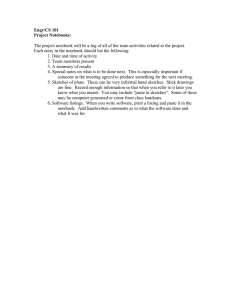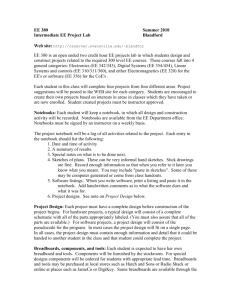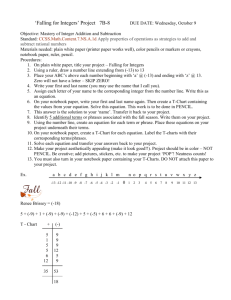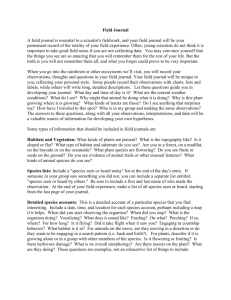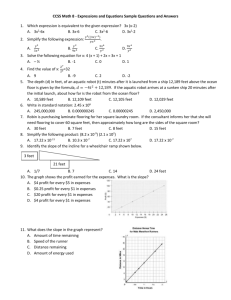Instructions for Aquatic Biodiversity Notebooks
advertisement
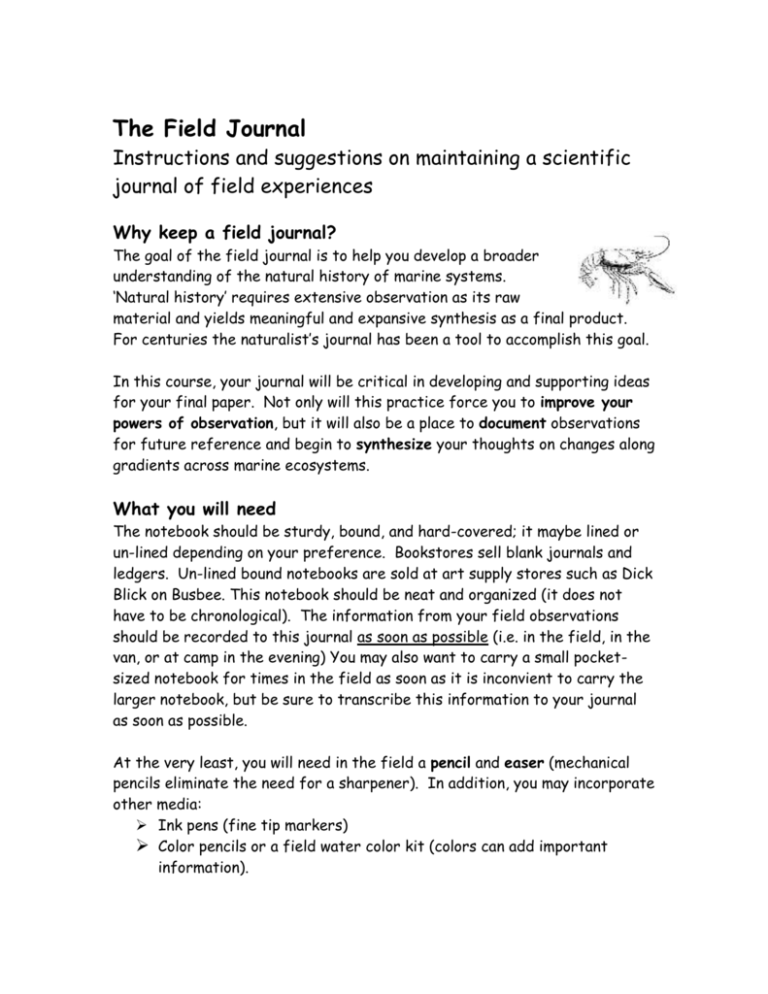
The Field Journal Instructions and suggestions on maintaining a scientific journal of field experiences Why keep a field journal? The goal of the field journal is to help you develop a broader understanding of the natural history of marine systems. ‘Natural history’ requires extensive observation as its raw material and yields meaningful and expansive synthesis as a final product. For centuries the naturalist’s journal has been a tool to accomplish this goal. In this course, your journal will be critical in developing and supporting ideas for your final paper. Not only will this practice force you to improve your powers of observation, but it will also be a place to document observations for future reference and begin to synthesize your thoughts on changes along gradients across marine ecosystems. What you will need The notebook should be sturdy, bound, and hard-covered; it maybe lined or un-lined depending on your preference. Bookstores sell blank journals and ledgers. Un-lined bound notebooks are sold at art supply stores such as Dick Blick on Busbee. This notebook should be neat and organized (it does not have to be chronological). The information from your field observations should be recorded to this journal as soon as possible (i.e. in the field, in the van, or at camp in the evening) You may also want to carry a small pocketsized notebook for times in the field as soon as it is inconvient to carry the larger notebook, but be sure to transcribe this information to your journal as soon as possible. At the very least, you will need in the field a pencil and easer (mechanical pencils eliminate the need for a sharpener). In addition, you may incorporate other media: Ink pens (fine tip markers) Color pencils or a field water color kit (colors can add important information). Types of information to be recorded in the notebooks: Required Field notes for each site visited: date, location (relative to nearest town, identifying county and state), type of habitat, weather conditions, … descriptions of habitat and microhabitats list of taxa collected and observed, noting where each taxon is found within the habitat. Do as best as you can but it is likely that you will not be able to document all species we encounter; I suggest comparing your taxa lists with fellow classmate in the van or around the campfire. Underline genus and species names with straight lines (capitalizing the former) and put squiggly lines under common names. Include collection identification number (if done). A crude map or diagram of study site indicating where we sampled and any other relevant information. You should included additional information as well. Here are some suggestions: description of collection techniques behaviors of animals in the field information espoused by your brilliant instructors (but don’t over do this; i.e. this is not a place to take lecture notes in the field) quick sketches concentrating on topography, habitats, behaviors, parts of organisms etc., recognizing that organisms collected can be sketched in more detail back at the lab anything else that might be of interest to you or others (be creative/observant). This might also include observations on local culture, land practices, etc. Great insights and understanding in science have arisen by bringing together disparate observations. non-visual information (sounds, smells, textures) information from laboratory examination of specimens, however the main focus of the notebook is field observations. You may wish to enhance field drawings from closer observations made in the field. Synthesis of information on at least one separate page for each system visited. Be sure to address the central question of the paper: were there any physical and biological trends/zonation along the gradients studied? How might any observed structures and behaviors explain why a given organisms inhabits that particular location? How do the taxa collected in one environment compare with those from another habitat, site, or region? How do particular sampling sites differ physically from one another. Don’t be afraid to speculate. This may be especially helpful in initiating thoughts relevant to your final paper. You may also include questions that arise from your observations but are not immediately answerable from the data at hand. Criteria used in grading notebooks Your journal may end up anywhere along a three-way continuum from the ‘scientific’ record, to the ‘artistic’ journal, to the ‘literary’ book. That is your decision and it is likely that the journal will evolve as the semester progresses (and hopefully though out your career). However, regardless of your finished product it must contain relevant scientific information both in drawings and writings. Specifically the journals will be graded for: 25% - Completeness, neatness, organization, and clarity (show me you made an effort). 25% - Accuracy 25% - Observation ability – make some original observations 25% - Synthesis of observations and thoughts - be creative. You should use both written descriptions and drawings, though the degree to which you use either will depend on whether you prefer expressing information in written form or more graphically. Use complete sentences in your writing. Feel free to be artistic with such things as page layouts and lettering. Drawings should be labeled as to what they are, their scale (e.g. 2x), and with relevant structures and other information. I suggest using pencil for the field notebooks. Write on only one side of the page to reduce smearing. Be Creative. Not all observations need to be immediately relevant to the study subjects (great ideas in science often arise from incidental observations). Some tips on field sketchs: Because time is limited in the field, you may wish to make partial field sketches then add detail upon return to the van, camp, or home. Quick notes on colors, textures and detail along side partial sketches will make this easier upon your return. However, often a quick field sketch alone will suffice in conveying information. Sketches may have to be very rapid and hence very simple. The sketch of an elk (right) was completed in about 5 seconds from a passing van. Seek out the lines that immediately jump out at you. A scribbling stroke is also a useful technique for rapid sketches in the field. The image on the right is enlarged from the ‘hawks in the tree’ drawing on a previous page. Note the pencil has rarely been lifted from the page in parts of the picture. Also note that the pencil was lifted when drawing finer branches, Though in reality all branches on the tree are connected, it is not necessary (or even desirable) to do this in the drawing.
